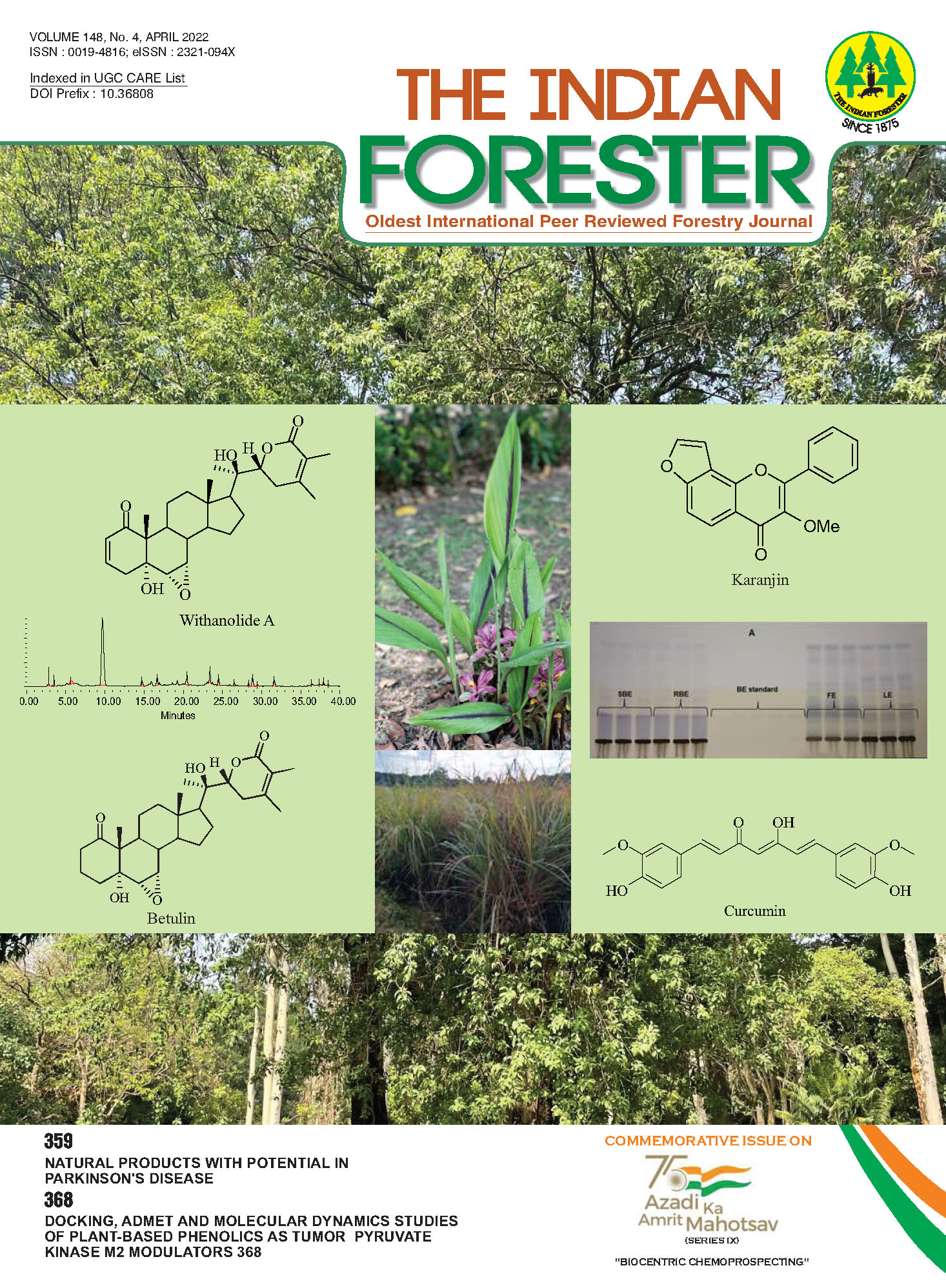Quantitative estimation of betulin in different plant parts of Dilleniapentagyna Roxb. through validated HPTLC method
DOI:
https://doi.org/10.36808/if/2022/v148i4/168691Keywords:
HPTLC, Betulin, Method Validation, Dillenia pentagyna, Quality Control.Abstract
A new, simple and accurate high-performance liquid chromatographic (HPTLC) method was developed for estimation of betulin (BE) in fruits, leaves, root bark and stem bark of Dillenia pentagyna, a RET species of Madhya Pradesh state of India. HPTLC aluminum plates precoated with 0.2 mm layer of silica gel 60F 254 were used to separate BE from the plant samples using the mobile phase, petroleum ether: ethyl acetate: acetonitrile (8: 2: 0.1, v/v/v). The anisaldehyde - sulphuric acid reagent was used to derivatize the plate followed by heating at 105°C on CAMAG HPTLC hot plate for 5 minutes. The peak corresponding to reference compound BE and that of the extract appeared at the same RF 0.21. Image of the plate was captured and HPTLC scan was performed densitometrically at ƛmax = 580 nm under max tungsten lamp in CAMAG TLC Scanner4 equipped with win CATS software. The developed HPTLC method was validated as per norms of the International Conference on Harmonization (ICH) for linearity, sensitivity, precision, accuracy and specificity. The BE content in fruit, leaf, root bark and stem bark samples of D. pentagyna was found as 0.101 ± 0.03%, 0.091 ± 0.09, 0.368 ± 0.07 and 0.440 ± 0.11% respectively.References
Boparai A., Niazi J., Bajwa N. and Singh P.A. (2017). Betulin a pentacyclic tri-terpenoid: an hour to rethink the compound, Open Access Journal of Translational Medicine and Research, 1(2): 53-59.
Choubey S., Chandra T.R., Rajeev K., Keeta K. and Deep K.G. (2015). Pharmacognostical evaluation of nagakesara used in different parts of India, International Journal of Ayurveda and Pharma Research, 3, 46-51.
Cichewicz R.H. and Kouzi S.A. (2004). Chemistry, biological activity, and chemotherapeutic potential of betulinic acid for the prevention and treatment of cancer and HIV infection, Medicinal Research Reviews, 24(1), 90-114.
Dubey P.C., Sikarwar R.L.S, Khanna K.K. and Tiwari A.P. (2009). Ethnobotany of DilleniapentagynaRoxb. In Vindhyan region of Madhya Pradesh, India, Natural Product Reports, 8: 546–8.
Fulda S. (2008). Betulinic acid for cancer treatment and prevention, International journal of molecular sciences, 9(6), 1096-1107.
Gandhi D. and Mehta P. (2013). Validated high-performance thin-layer chromatographic method for the quantification of betulinic acid from two Indian plants of the species Dillenia and Ziziphus, JPC-Journal of Planar Chromatography-Modern TLC, 26(4), 331-335.
Ghimire K. and Bastakoti R.R. (2009). Ethnomedicinal knowledge and healthcare practices among the Tharus of Nawalparasi district in central Nepal, Forest ecology and management, 257(10), 2066-2072.
Gurudeva M.R. and Gurudev K. (2019). Dilleniapentagyna, a review of ethnomedicinal, phytochemical and pharmacological activities, My forest, 55(2), 19-25.
International Conference on Harmonization (ICH) (2005). Guideline Q2 (R1): validation of analytical procedures: text and methodology. Geneva, October 1994. https://database.ich.org sites/default/files/Q2%28R1%29%20Guideline.pdf.
Khanum A., Khan I. and Ali A. (2007). Ethnomedicine and human welfare, Ukaaz Publications, 4, 52.
Khare C.P. (2007). Indian Medicinal Plants, Springer-Verlag Berlin, 214: 52-23.
Mehta D.G.P. (2013). Dillenia indica Linn. and Dilleniapentagyna Roxb.: Pharmacognostic, phytochemical and therapeutic aspects, Journal of Applied Pharmaceutical Science, 3(11), 134-142.
Rosangkima G. and Prasad S.B. (2004). Antitumour activity of some plants from Meghalaya and Mizoram against murine ascites Dalton's lymphoma, Indian Journal of Experimental Biology, 42, 981-988.
Rosangkima G. and Prasad S.B. (2008). Inhibitory effect of Dilleniapentagyna stem bark extract on cisplatin and benzo [a] pyrene-induced mutagenicity. Canadian journal of pure and applied sciences, 381.
Sharma H.K., Chhangte L. and Dolui A.K. (2001). Traditional medicinal plants in Mizoram, India, Fitoterapia, 72, 146–61.
Sikarwar R.L.S., Dubey P.C. and Tiwari A.P. (2016). Dilleniapentagyna Roxb. (Dilleniaceae) in Central India: a Plea for its Conservation. Indian Forester, 142(7), 649-653.
Singha A.K., Bhattacharjee B., Ghosh R., De U. and Maiti D. (2013). Antibacterial, anti-alpha glucosidase and antioxidant properties of Dilleniapentagyna Roxb. (Dilleniaceae), Asian Journal of Pharmaceutical and Clinical Research, 6(4), 173-177.
Yazan S.L. and Armania N. (2014). Dillenia species: A review of the traditional uses, active constituents and pharmacological properties from pre-clinical studies, Pharmaceutical biology, 52(7), 890-897.
Paul A., Rajiung M., Zaman K., Chaudhary S.K. and Shakya A. (2020). Quantification of the bioactive marker resveratrol in Morus alba Linn. fruits by high–performance thin-layer chromatography, JPC-Journal of Planar ChromatographyModern TLC, 33(5), 481-487.
Anand S.P., Jayakumar E., Jeyachandran R., Nandagobalan V. and Doss A. (2012). Direct organogenesis of Passiflora foetida L. through nodal explants. Plant Tissue Culture and Biotechnology, 22(1), 87-91.
Julsing K.M., Quax J.W. and Kayser O. (2007). The Engineering of medicinal plants: Prospects and limitations of medicinal plant biotechnology. In: Medicinal Plant Biotechnology (K. Oliver, J.Q. Wim, Eds.), WILEY-VCH Verlag GmbH and Co. KGaA, Weinheim.
Joshi D.D. and Uniyal R.C. (2008). Different chemo types of Gokhru (Tribulus terrestris): A herb used for improving physique and physical performance, International Journal of Green Pharmacy, 2(3), 158 – 161.
Akinmoladun A.C., Ibukun E.O., Afor E., Obuotor E.M. and Farombi E.O. (2007). Phytochemical constituent and antioxidant activity of extract from the leaves of Ocimumgratissimum. Scientific Research and Essays, 2(5), 163-166.
Shakya A., Gogoi N., Chaudhary S.K., Bhat H.R. and Ghosh S.K. (2019). Development and validation of a high-performance thin-layer chromatography method for the quantification of rutin in the fruit pulp of Benincasahispida (Thunb.) Cogniaux. JPCJournal of Planar Chromatography-Modern TLC, 32(5), 371-377.
Shakya A., Chaudhary S.K., Bhat H.R., Gogoi N. and Ghosh S.K. (2019). A rapid high-performance thin-layer chromatographic method to estimate quercetin in Benincasahispida (Thunb.) Cogn. fruit pulp. JPC-Journal of Planar Chromatography-Modern TLC, 32(6), pp.467-474.
Kaushik S., Sharma P., Jain A. and Sikarwar M.S. (2010). Preliminary phytochemical screening and HPTLC fingerprinting of Nicotiana tabacum leaf. Journal of Pharmaceutical Research, 3(5), p.144.
Vasudevan H. (2009). DNA fingerprinting in the standardization of Herbs and Nutraceuticals. The Science Creative, Quaterly, 4.
Downloads
Downloads
Published
How to Cite
Issue
Section
License
Unless otherwise stated, copyright or similar rights in all materials presented on the site, including graphical images, are owned by Indian Forester.





